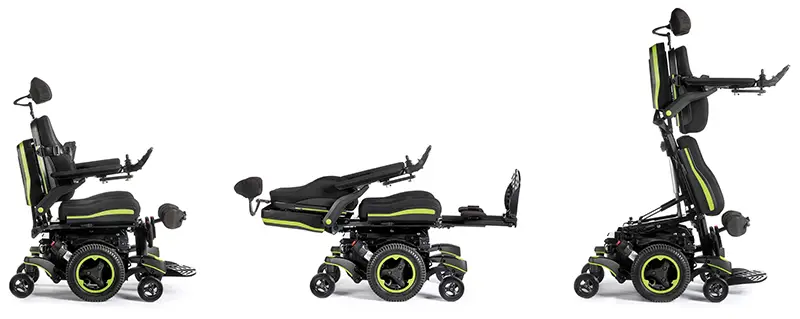What is the "Memory Seating" function on a power wheelchair?
Numerous studies have demonstrated the benefits of standing for wheelchair users. There are anatomical, physiological, and social benefits, all of which can improve participation in activities of daily living.
However, there are different types of sit-to-stand systems on wheelchairs. Some are simple mechanical options – generally on manual wheelchairs – and others are electrically powered, more typically seen on power wheelchairs. These systems have varying degrees of technical sophistication. A basic power seating system (even one with recline, tilt, and sit-to-stand) may not be suitable for many individuals due to range of motion, pain, or health needs. These users require a more specialized series of seat movements (i.e., "kinematics") for safe and comfortable use. If there is not good biomechanical alignment with the seat because of the intermediate positions when moving between seating positions, the effect of having power seating could be harmful rather than beneficial. In order to respond to these needs, advanced powered seating enables the highest level of consistency and configurability.
Memory seating is available in the SEDEO PRO ADVANCED seating system, which can be found on the QUICKIE Q700 M and Q700-UP M power wheelchairs. The system has programmable memory positions with a wide range of adjustments to return to the same position every time. This is the "Memory Seating" function. It is also possible to define one of the saved Memory Seating positions ("relax," for example) as an intermediate position. This allows the system to follow the same sequence of movements in between positions every time. This way, we have maximum configurability of the kinematics for moving forward, upright, or back in space according to the specific requirements of the wheelchair user. This is referred to as the "trajectory," or sequence, of the memory seating. You can save up to six programmable positions and transition them with a simple press of a button. If you want more than five functions, you can assign up to 10 commands on each box.
How does a Memory Seating trajectory work?
On the powered standing models, the memory positions are:
- M1: Seated
- M2: Supine
- M3: Pressure relief
- M4: Elevate
- M5: Any position
Once the mechanical adjustments have been made to suit the user's body shape and the Memory Seating positions have been established, it is possible to set the Memory Seating trajectory to move between significant seat position changes. The principle is simple: all you have to do is set the chair's electronic parameters so that it passes through one of the memory positions before reaching the final position. This creates a defined trajectory. For example, starting from the Seated position, the wheelchair passes through the Supine position before reaching the Standing position.

How does a specific Memory Seating trajectory setting benefit the wheelchair user?
The transition through a personalized intermediate position has two purposes. First, it maintains the body's position in the chair for stability when returning to drive. For example: when moving in and out of anterior tilt, an intermediate position like the tilted and reclined "Relax" option helps keep the pelvis positioned back on the seat. This can also enhance comfort and reduce friction on the skin.
In fact, in a traditional sit-to-stand seat movement, despite appropriate mechanical adjustment of the knee supports, there is often a forward slide when moving into standing. This can lead to a displacement or tilting of the pelvis, accompanied by shearing, joint or muscular stress, and excessive pressure on the knees and shins. The same thing can happen when returning to the previous sitting position. By moving to the Supine position first, the chair will lengthen and therefore extend the user's body, then tilt the seat forward in the same way as a standing table used in rehabilitation. This makes it possible to stand up slowly and progressively.
In the Relax position, the chair tilts the seat backwards and opens the backrest while compensating for the leg rest. In this way, the user is well positioned fully back in the seat. As the seat tilts forward, the wheelchair gradually unfolds, allowing the user to reach a standing position in one fluid motion. Use of the trajectory function for Memory Seating positions provides comfort, but more importantly it reduces the risk of skin breakdown by maintaining posture during the raising process.
It is even possible to choose one Memory Seating trajectory for raising and another one for lowering. Note that once a trajectory has been established for raising, the wheelchair will always pass through this intermediate position regardless of its original position. For lowering, the seat movement action may vary depending on certain electronic parameters. These can be modified using programming software.
Are the Memory Seating positions themselves customizable? Yes! Full programmability is a key feature of the memory positions. The preferred position can be saved at the touch of a button. This way, the factory setting is overwritten and the chair will always adopt the position (standing, sitting, relax, etc.) best suited to the user. Memory Seating positions can also be renamed or deleted if certain ones are not required.
How are Memory Seating functions programmed?
Learn how to program Memory Seating functions with our Guide to Memory Seat Programming.
As an occupational therapist specializing in the treatment of spinal cord injuries, Alexandre joined the Sunrise Medical France team as a product specialist before taking up his current position as Key Account Manager. His aim is to use the experience he has gained in his various roles and his vision as a therapist to offer quality advice and support to distributors, prescribers, and clients.